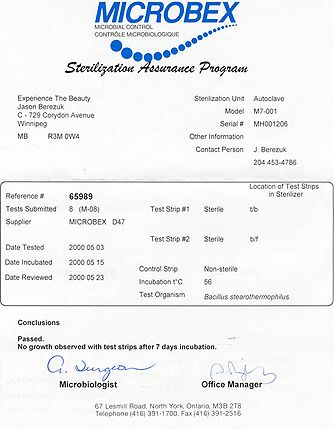Spore testing
In North America, spore testing is the most common way of ensuring that an autoclave is working. In short, it works by running a package of living spores through an autoclave. This package is then sent to a laboratory which attempts to incubate it — if anything is still alive, then the autoclave did not achieve sterility.
Most areas of North America legally require studios to perform regular spore testing as a part of health board certification, and studios should be happy to show you copies of their latest testing (many will proudly display them in their lobby). It should be noted that European certification works quite differently and involves daily charting of autoclave pressures, temperatures, and times to detect functional anomalies (so there's no point in asking to see the spore tests of a studio in London UK).
It is important to point out that spore tests are not a guarantee that everything is sterile, and also that if a spore test fails that all customers for the previous month or more may have been in danger (which is in part why they're not in common use in Europe). Also, even if an autoclave is functioning perfectly, if it's not being used properly (i.e. overpacking, placing unsuitable objects in it, and so on), it may not sterilize the items. Knowing how to use an autoclave is as important as knowing that it's functional!
Whoever sold you your autoclave should be able to give you references to local testing services.
Silverelf wrote in to add,
The owner of the autoclave acquires a biological sample from a reputable testing facility. This sample contains an endospore-forming bacteria, commonly a Bacillus strain. (Note that this 'spore' is different from fungal spores). This sample is then placed in the autoclave and the autoclave is run through a normal cycle. The sample is sent to the testing facility, where it is incubated and then tested to see if it contains any live bacteria. While most bacteria can be killed rather quickly in a high-heat environment, endospore forming bacteria are much more resistant to heat. An improperly functioning autoclave (or an incompetent autoclave operator) will not result in complete sterilization, opening up the possibility for infection. Chemical-indicator strips on autoclave bags only indicate that the bag has been heated, they do not prove sterilization. Up to date spore tests should be asked for when researching any new shop.
